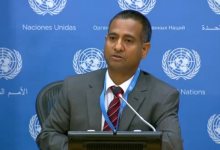Iran: Journalists under siege I Ann sty International http://wwwamnestyorg/en/mws-and-i.çdates/iran-journalists-urder-sieg ,
AMNESTY
I NIERNATI ONAL ________________________
In your country:
1 of 7 27/07 2010 14:19
Iran: Journalists under siege I Ant' sty International http://wwwamnestyorg/en/mws-and-i .çdates/iran-journalists-uzxler-sieg.
> Home > Iran: Journalists under siege
IRAN: JOURNALISTS UNDER SIEGE
30 April 2010
‘Around 70
journalists are
now in the
prisons of the
Islamic
Republic and
many others,
like me, are
free on bail,
lacking any
security. We
are afraid that
anything that
we write may
be used as
evidence of
“propaganda
against the
system” or
“conspiracy
against
national
security'l My
colleagues and
I tiy to write as
little as
possible.”
Open letter
from journalist
Zhila Bani
Ya'qoub to the
Head of Iranian
Judiciary
Iranian
journalists and
bloggers are
increasingly
under siege in
one of the
biggest
crackdowns on
independent
voices and
Embed:
Iran: Journalists under siege I Ant sty International ltp://wwwamnestyorg/en/mws-and-i .çdates/iran-journalists-uzx ler-sieg
dissent in Iran's The killing of Neda Agha Soltan during a
demonstration was reported worldwide
modern history. ©AForaphics nk
Since last
year's disputed presidential election, which brought millions of
protesters onto the streets, the authorities have intensified
their long-standing suppression of both the traditional Iranian
media and the rising number of “citizen journalists” who use
new technology to expose human rights violations.
Iran has been described by press freedom organizations as
the biggest jailer of journalists in the world.
Hassiba Hadj Sahraoui, Amnesty International's Deputy
Director for the Middle East and North Africa said: “Since the
protests, the government's growing bunker mentality has led
to mounting waves of repression aimed at suppressing any
criticism of the authorities or independent reporting on the
human rights situation in the country.
“Dozens of newspapers and websites have been closed, and
scores of journalists and bloggers have been arrested and
are held as prisoners of conscience or have had to flee the
country for their own safety.
“Contact with some foreign media has been criminalized and
a new ‘Cyber-Crimes Law' is already having major
implications for freedom of expression. The authorities must
urgently relax both the long standing and new sweeping
restrictions and immediately release those held as prisoners
of conscience.”
The Association of Iranian Journalists was closed by the
authorities in August 2009 and a number of its officials
arrested, including Secretary Badrolsadat Mofidi who by April
2010 had spent four months in detention without charge or
trial.
Blogging, once an effective way around Iran's draconian
press censorship, is now a risky business. The once-thriving
blogosphere is under fire, with those involved subjected to
arbitrary arrest or harassment. Some have had to flee the
country for their own safety.
Aida Saadat, a freelance journalist and human rights
campaigner, active with the One Million Signature Campaign
and the Commiftee of Human Rights Reporters was
repeatedly interrogated; and beaten up while walking home.
Fearing for her life, she eventually fled Iran.
She told Amnesty International: “I could not find any human
3 of 7 27/07 2010 14:19
Iran: Journalists under siege I Ant sty International http://wwwann lestyorg/en/mws-and-1 .çdates/iran-journalists-urKIer-sieg.
rights or other organization to defend me, as a journalist.
They had been silenced. The men who attacked me said ‘this
is just a warning. Next time we will kill you for your activities
against the people of our country...' This is what we have
been facing. I and so many others had to leave. Our lives
were at stake.”
Many of the detainees and those who fled worked for papers
or online publications which supported or could have been
perceived as supporting the defeated reformist candidates in
the presidential elections, or are freelancers, some of whom
who had lost jobs with previously-banned publications while
others provided an independent voice, often about the human
rights situation. At one point officials arrested the entire staff
of Kalameh Sabz, a newspaper established by opposition
candidate Mir Hossein Mousavi.
Prisoner of conscience Isa Saharkhiz, a prominent journalist
working with reformist candidate Mehdi Karroubi, was
arrested in July 2009 during the post election unrest; by April
2010 he had yet to be charged with any offence. His son,
Mehdi, a US-based blogger, explains: “What happened is at
one point they realized that the media is playing a big role at
getting the news out and getting the truth out. So what they
did was they arrested well known journalists, so other
journalists who are working will learn from this... and they will
write just what the state wants them to write.”
Other targets included journalists writing on human rights
issues, such as the internationally-acclaimed Emadeddin
Baghi, founder of the Association for the Defence of
Prisoners' Rights. Some journalists have been sentenced to
lengthy prison terms after conviction in mass “show trials”.
Detainees have faced human rights violations ranging from
torture and other ill-treatment, including beatings, solitary
confinement for lengthy periods, to grossly unfair trials. Many
have been held incommunicado for weeks or months without
charge or trial.
Some of those freed still remain under pressure, having had
to give up the deeds to their — or their relatives' — houses to
raise bail. Detainees' families have been harassed or
temporarily detained; some have been warned their loved
ones won't be freed if they speak to the media about their
plight.
Criminalizing contacts with foreigners: The ‘Velvet
Coup'
With Iran's media limited in their reporting by government
4of7 27/07 2010 14:19
Iran: Journalists under siege I Ant sty International lttp://wwwann lestyorg/en/mws-and-1 .çdates/iran-journalists-urKIer-sieg
censorship and fearful of crossing the “red line” over the
decades, many Iranians have in the past tuned in to foreign
radio stations, or watched international TV networks via
illegal, though previously largely tolerated, satellite dishes.
Since the first election of President Ahmadinejad in 2005,
Iranian security forces have conducted an increasing number
of raids to seize such dishes.
The authorities have also reduced the number of foreign
correspondents based in Iran; when political unrest erupted in
mid-2009, those remaining were barred from covering mass
opposition rallies.
International media broadcasting in Persian were singled out
and their Iranian contributors targeted. The BBC's Tehran
correspondent was expelled. Maziar Bahari, working for
Newsweek, - one of two international journalists arrested at
the time - was released only after making a dubious public
“confession” following weeks of physical and psychological
torture.
Prosecutors in mass “show trials” accused foreign
broadcasters like the BBC and the Voice of America (VOA) of
stage-managing the protests and planning a “soft coup”.
Some of the accused were charged with working with foreign
channels in order to “incite and provoke public opinion”.
In January, both the BBC and VOA were included on a list of
“subversive” organizations which Iranians were banned from
contacting. Both networks have had their satellite
transmissions into Iran blocked but the truth is that now any
contribution to any overseas Persian-language broadcaster is
regarded as suspicious if not seditious.
From cassettes to Twitter
After decades of repression, Iranians are adept at finding a
way around state censorship. In the 1970s, Ayatollah
Khomeini, then an exiled opponent of the former Shah, used
cassette tapes of his sermons smuggled in from abroad to
denounce the Shah's increasingly autocratic rule. Those
cassettes played an important part in the subsequent Islamic
Revolution.
In 1999, the closure of Salam newspaper led to mass
student-led protests - and eventually to violent
confrontations between them and the security forces. Over
the next few years, the media became a focal point in the
power struggle between conservative and reformist factions.
More than a hundred newspapers and periodicals were
5 of 7 27/07 2010 14:19
Iran: Journalists under siege I Ant' sty International ltp://www ,an'niesty ,org/en/rcws-and-i ,çdates/iran-journalists-uix ler-sieg , , ,
closed. There was a explosion of internet use as Iranian
writers increasingly turned to it as virtually the only remaining
forum for free expression. Internet usage in Iran in recent
years has grown faster than in any other Middle Eastern
country.
But the authorities have been hot on the bloggers' heels,
filtering and blocking access to many sites, ranging from
those considered ‘immoral or “anti-Islamic' to political
websites or blogs critical of the government.
At one stage, an Iranian official claimed that five million sites
were being blocked. Facebook and Twitter - used to spread
information about last year's demonstrations - were briefly
shut down and other internet sites such as social networking
site Badoo have been banned.
Last February, the authorities announced that access to
Google's email service was to be permanently blocked. Some
tech savvy Iranians continue to find their way around the
system, using filter-busting software, encryption services or
“proxy” internet servers outside Iran, although they have been
hampered by speed slowdowns, or even brief blockages of
internet access.
The latest salvo in the battle came when the Cyber-Crimes
Law came into effect in July 2009; human rights groups say it
could help the authorities track down government critics. But
images of the killing of Neda Agha Soltan during a
demonstration in July 2009, captured by mobile phone
camera and almost instantly distributed across the world,
became the symbol of the futility of attempts by the authorities
to conceal the truth and control new media and social
networks.
It's all led to what Mehdi Saharkhiz describes as “a cat and
mouse game,” with Iranians trying to circumvent official filters
as soon as they are set up. He also points to a huge rise in
the number of “citizen journalists” many of whom have
managed to send news or videos for posting on his US-based
website.
During the 2009 protests, he says the amount of video
material coming in was “staggering”. Some contributors, he
says, are professional journalists who now prefer to work
anonymously in order to keep under the official radar. Others
may be friends or neighbours of political prisoners, or just
individuals who see something they want to share with others.
“Every person has become a media,” he said. “Even taking
pictures of this stuff is extremely dangerous for them. But they
6 of 7 27/07 2010 14:19
Iran: Journalists under siege I Ann sty International http://wwwamnestyorg/en/mws-and-i.çdates/iran-journalists-urder-sieg ,
want to do this because they want to be heard. You can't
control 70 million people.”
S1 1 Français Españo l
7 of 7 27/07 2010 14:19







